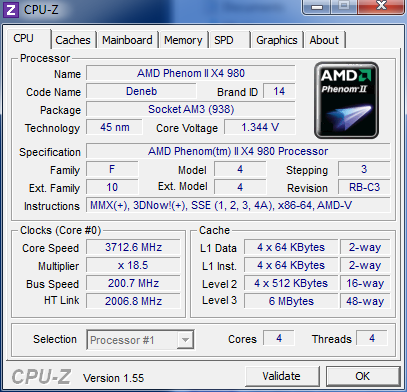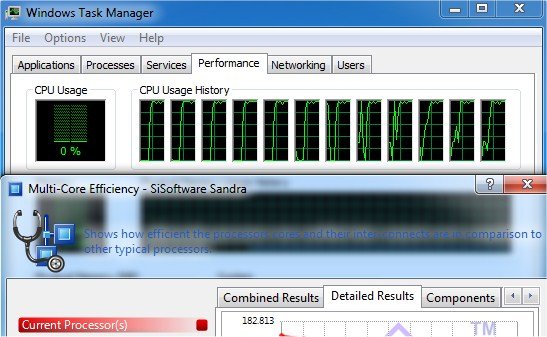AMD launched the Phenom II X4 980BE, bumping the clockspeed of its processor to 3.7GHz. Priced at $195, how does this processor compete against Intel’s newest Sandy Bridge?
INTRODUCTION
We thought we saw the last of the K10 based processors from AMD with the release of the Phenom X6 1100T BE and the Phenom X4 970 BE, but we were wrong. While we probably will not see any new six-core Phemoms until Bulldozer arrives, AMD has bumped up the fastest quad core by 100MHz and put out the Phenom X4 980 BE. The Phenom X4 980 BE runs at 3.7 GHz and costs $185, and will replace the current flagship quad core Phenom II X4 970 BE. Besides the 100MHz speed bump, there are no other changes to the processor. The processor still fits the 125W TDP, with 6MB L3 and 2MB total L2. It is still based on the Deneb core so users will not get TurboCore support like the six-core Thuban based processor.
The new processor’s pricing means that the processor will be in direct competition against the Intel Core i5 2500K. We have already seen the performance of the Sandy Bridge and with the Hyperthreading support, the Intel system would ended up faster in heavy threaded application. However, with 3.7 GHz running on all four cores, AMD wins in the raw clockspeed–the Core i5 tops at 3.3GHz when all four cores active. AMD also paves a better upgrade path as the processor will be compatible with AM2+ and AM3 boards. So, there is no need for a major upgrade for users who already own a recent AMD board.
Furthermore, motherboard manufacturers such as ASUS and GIGABYTE have announced that some of the current AM3 boards will be compatible with the upcoming AM3+ processor (Bulldozer). While we cannot know performance numbers or issues until we get our hands at the AM3+ processor, it does at least give some comfort to AMD users that they can run Bulldozer without having to buy a new board.
Testing & Methodology
Intel H67/P67 system:
- Skythe Ninja Rev B cooling
- Asus P8P67 Deluxe
- 2x2GB Kingston DDR3 @ 1600 MHz
- Seagate 7200.12
- XFX HD5870 Eyefinity Edition 2 GB video card
- Cooler Master UCP 900W
Intel X58 system:
- Core i7 920 OC to 2.8GHz
- Cooler Master V6
- Gigabyte EX58-UD4P
- 6 GB Kingston DDR3 @ 1600 MHz
- Seagate 7200.12
- Gigabyte HD5770 Super Overclocked
- Cooler Master UCP 900W
AMD Phenom II X6 system:
- AMD Phenom X6 1100T and X4 980BE
- Thermalright SI-128
- 4 GB Kingston DDR3 @ 1600 MHz
- ASUS Crosshair IV Extreme
- Seagate 7200.12
- Gigabyte HD5770 Super Overclocked
- Cooler Master UCP 900W
The OS for all systems were Windows 7 Professional 64-bit. We used Acronis True Image 11 to set up each system with a fresh install of Windows 7
aida64 v.1.50
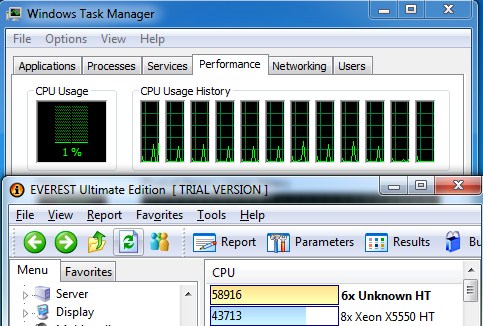
“EVEREST Ultimate Edition is an industry leading system diagnostics and benchmarking solution for enthusiasts PC users, based on the award-winning EVEREST Technology. During system optimizations and tweaking it provides essential system and overclock information, advanced hardware monitoring and diagnostics capabilities to check the effects of the applied settings. CPU, FPU and memory benchmarks are available to measure the actual system performance and compare it to previous states or other systems. Furthermore, complete software, operating system and security information makes EVEREST Ultimate Edition a comprehensive system diagnostics tool that offers a total of 100 pages of information about your PC.”
CPU AES
This integer benchmark measures CPU performance using AES (a.k.a. Rijndael) data encryption. It utilizes Vincent Rijmen, Antoon Bosselaers’, and Paulo Barreto’s public domain C code in ECB mode.
CPU AES test uses only the basic x86 instructions, the test consumes 48 MB memory, and it is Hyper Threading, multi-processor (SMP) and multi-core (CMP) aware.
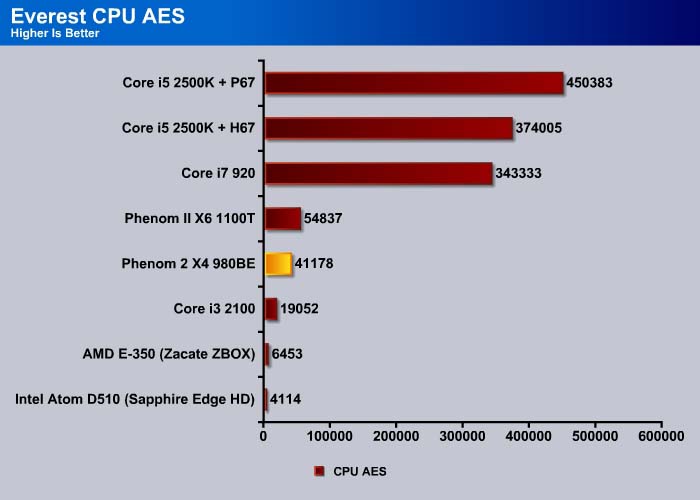
AMD Phenom processors do not support AES instruction so their performance lags behind the Intel Core i7 and Core i5 processors.
CPU PhotoWorxx
This integer benchmark performs different common tasks used during digital photo processing.
It performs the following tasks on a very large RGB image:
• Fill
• Flip
• Rotate90R (rotate 90 degrees CW)
• Rotate90L (rotate 90 degrees CCW)
• Random (fill the image with random colored pixels)
• RGB2BW (color to black & white conversion)
• Difference
• Crop
This benchmark stresses the integer arithmetic and multiplication execution units of the CPU and also the memory subsystem.
CPU PhotoWorxx test uses only the basic x86 instructions, and it is Hyper Threading, multi-processor (SMP) and multi-core (CMP) aware.
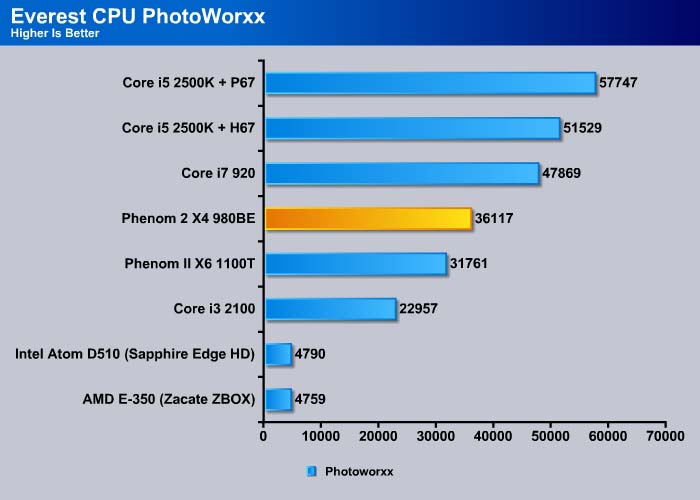
The PhotoWorxx tests both the CPU and the memory subsystem where we can see the higher clockspeed — the 980BE comes ahead of the X6 1100T but still behind the Core i7 920.
CPU Queen
This simple integer benchmark focuses on the branch prediction capabilities and the misprediction penalties of the CPU. It finds the solutions for the classic “Queens problem” on a 10 by 10 sized chessboard.
CPU Queen test uses integer MMX, SSE2 and SSSE3 optimizations. It consumes less than 1 MB system memory and it is Hyper Threading, multi-processor (SMP) and multi-core (CMP) aware.
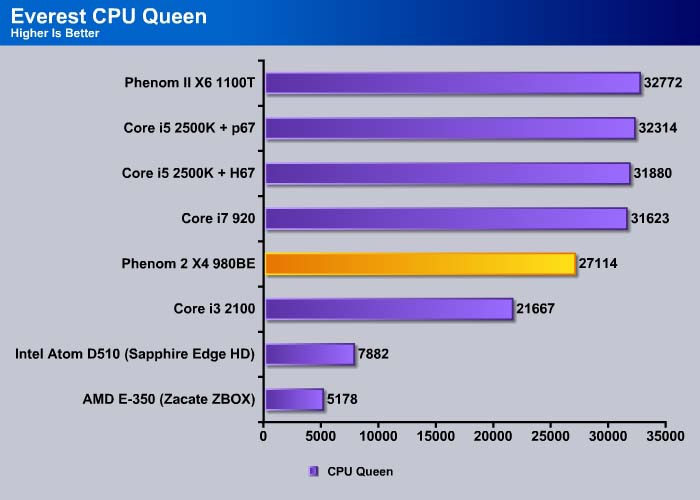
The CPU Queen test shows us the advantage of having extra cores as the Phenom II X6 1100T tops our chart. Intel processors that support Hyperthreading perform quite well here as well. The 980BE falls behind the Core i7 920 here.
CPU Zlib
This integer benchmark measures combined CPU and memory subsystem performance through the public ZLib compression library Version 1.2.3 (http://www.zlib.net).
CPU ZLib test uses only the basic x86 instructions, and it is Hyper Threading, multi-processor (SMP) and multi-core (CMP) aware.
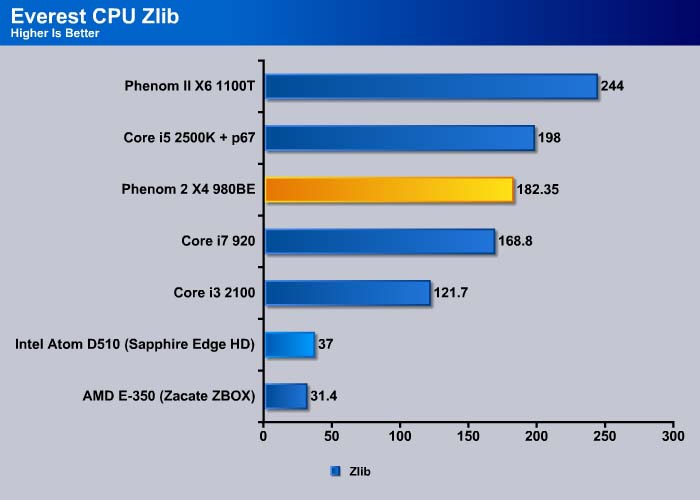
The 980BE is about 8% faster here. However, the Core i5 2500K beats out the 980BE.

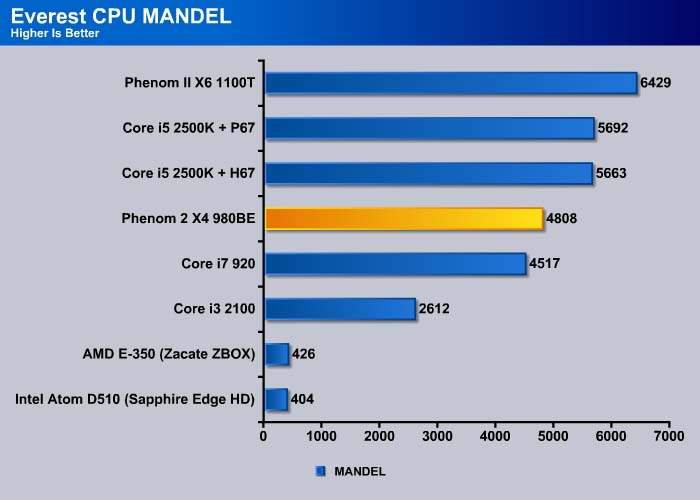
The 980BE narrowly edges out the Core i7 920 in both the Mandel and Julia tests but again cannot compete against the Core i5 2500K.
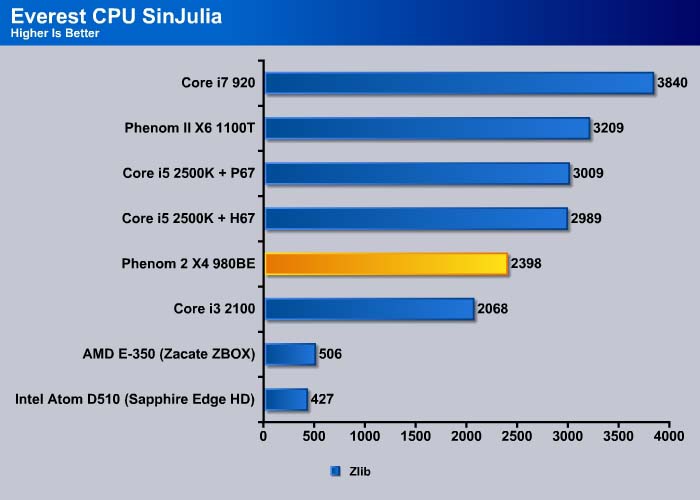
SinJulia measures the extended precision (80-bit) floating point calculation where the Core i7 920 trumps other processors.
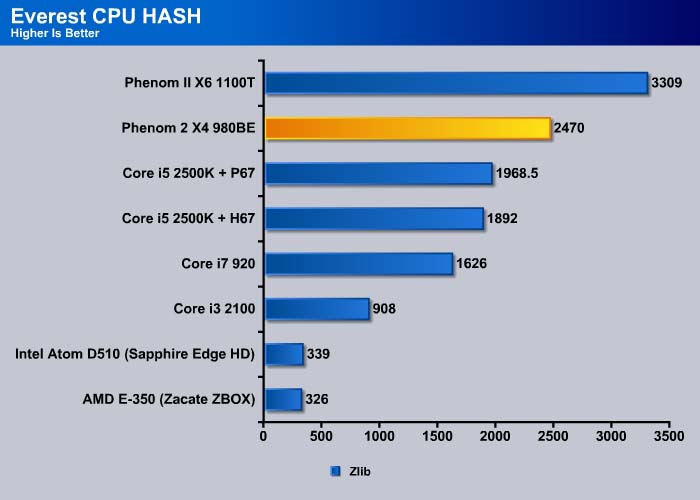

VP8 is also a new benchmark from AIDA64 that measures the video encoding ability of the processor. Obviously with video encoding, having extra cores would definitely pay off. Here, the 980BE beats the Core i7 920 due to faster clockspeed but comes behind the Core i5 2500K.
Everest Memory
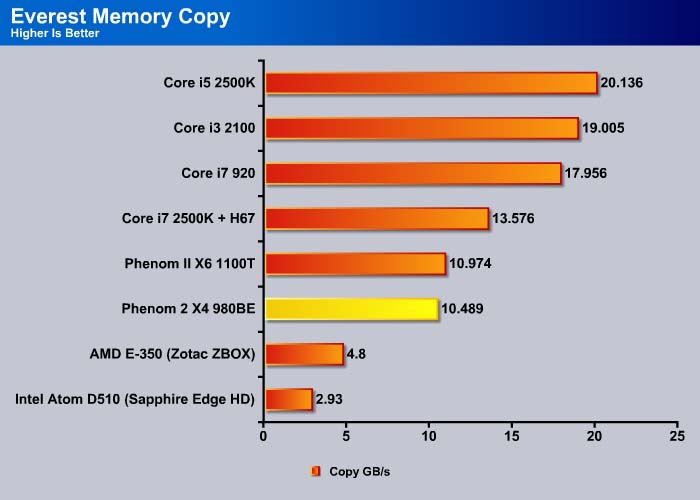
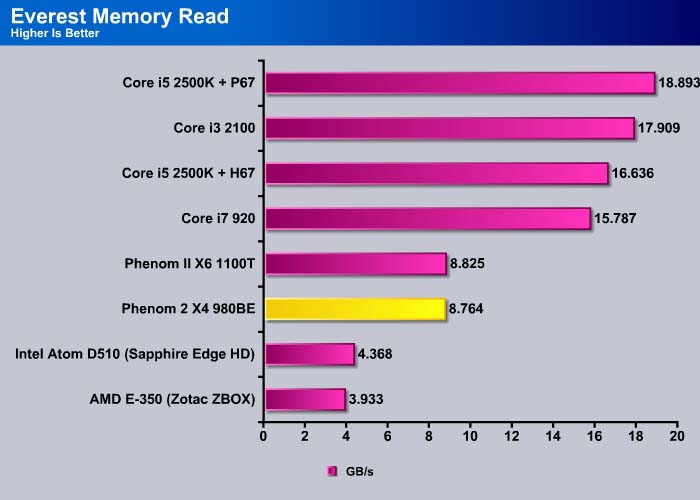
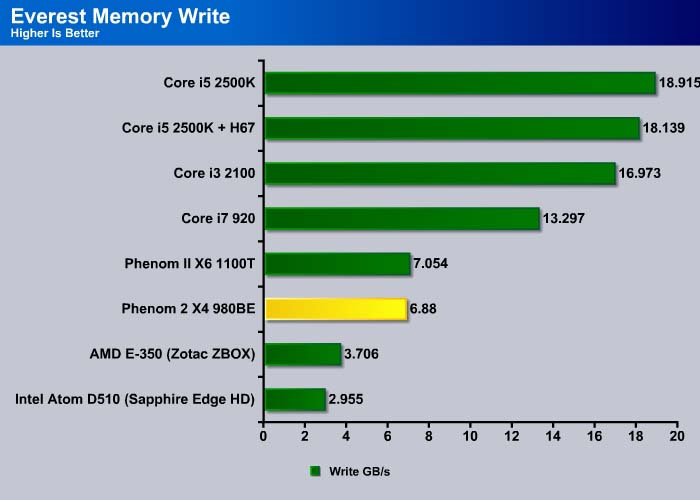
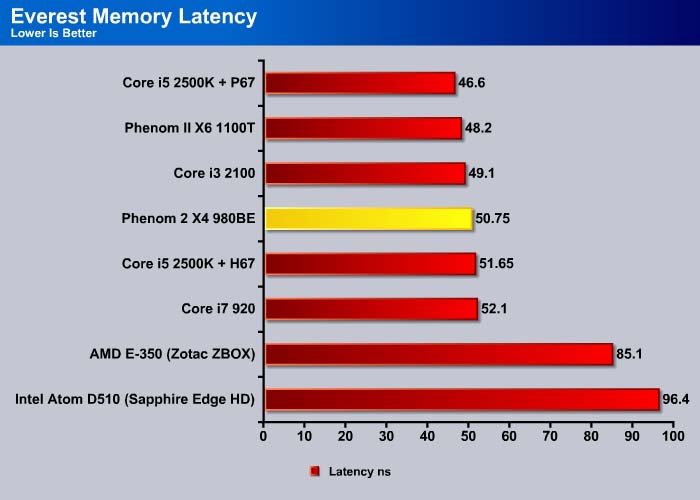
With the same memory controller on the AMD processors, we get very similar memory performance across all AMD processors. The latest Intel Sandy Bridge processors have a refined memory controller that takes the lead in the memory performance, even beating the triple channel memory supporting Nehalem based Core i7’s. We will have to wait till Bulldozer is released to see if the memory performance can be improved for the next generation of AMD processors.
Sisoft Sandra 2011b
“SiSoftware Sandra (the System Analyzer, Diagnostic and Reporting Assistant) is an information & diagnostic utility. It should provide most of the information (including undocumented) you need to know about your hardware, software and other devices whether hardware or software. It works along the lines of other Windows utilities, however it tries to go beyond them and show you more of what’s really going on. Giving the user the ability to draw comparisons at both a high and low-level. You can get information about the CPU, chipset, video adapter, ports, printers, sound card, memory, network, Windows internals, AGP, PCI, PCI-X, PCIe (PCI Express), database, USB, USB2, 1394/Firewire, etc.”

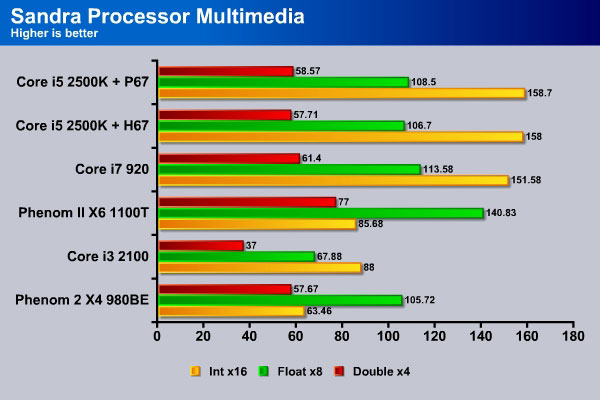
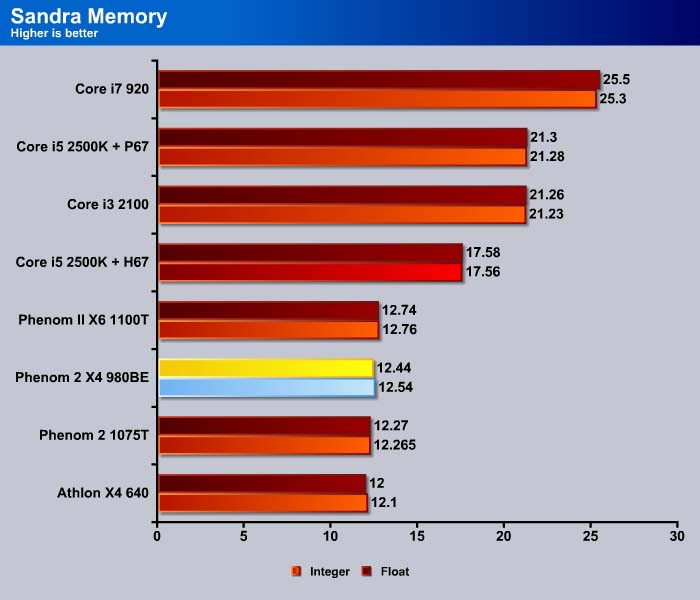
The 980BE comes in on the low end of the performance spectrum in the SANDRA test.
Cinebench R11.5
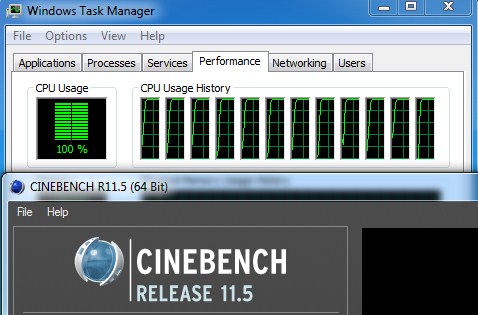
“CINEBENCH is a real-world test suite that assesses your computer’s performance capabilities. MAXON CINEBENCH is based on MAXON’s award-winning animation software, CINEMA 4D, which is used extensively by studios and production houses worldwide for 3D content creation. MAXON software has been used in blockbuster movies such as Spider-Man, Star Wars, The Chronicles of Narnia and many more. MAXON CINEBENCH runs several tests on your computer to measure the performance of the main processor and the graphics card under real world circumstances. The benchmark application makes use of up to 16 CPUs or CPU cores and is available for Windows (32-bit and 64-Bit) and Macintosh (PPC and Intel-based). The resulting values among different operating systems are 100% comparable and therefore very useful with regard to purchasing decision-making. It can also be used as a marketing tool for hardware vendors or simply to compare hardware among colleagues or friends.”
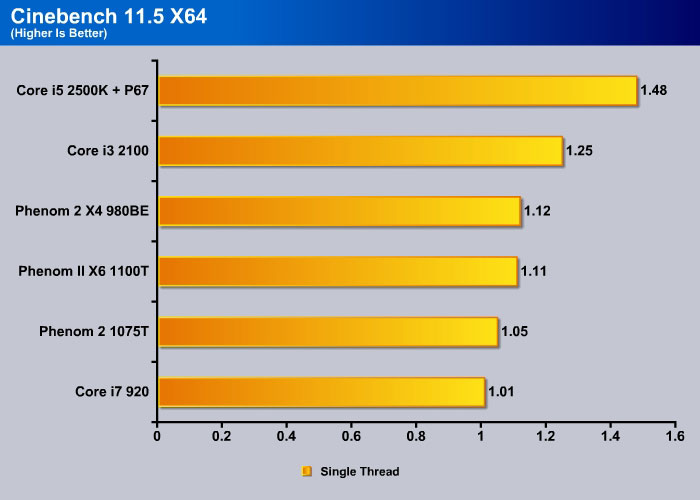

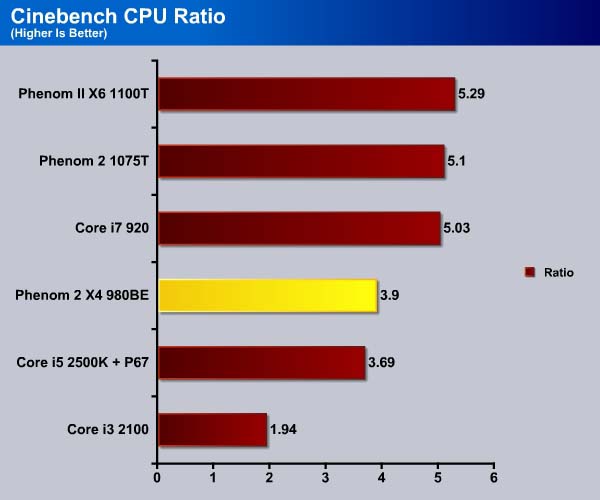
PCMark Vantage
PCMark Vantage is the latest system benchmark tool from Futuremark. The benchmark consists of tests such as application launches, file searches, web browsing, video playback, photo editing, and gaming.
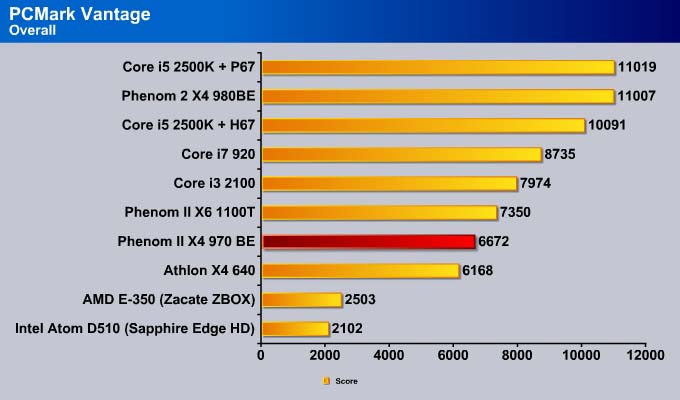
In PCMark Vantage, the Phenom II X4 980BE is quite competitive, coming in just a tad under the Core i5 2500K, and is faster than the Core i7 920, thanks to its 3.7GHz processing power.
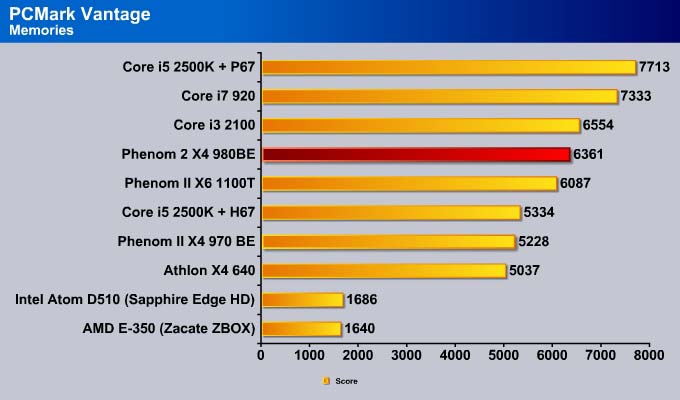
Nothing out of the ordinary with the memory performance of the 980BE.
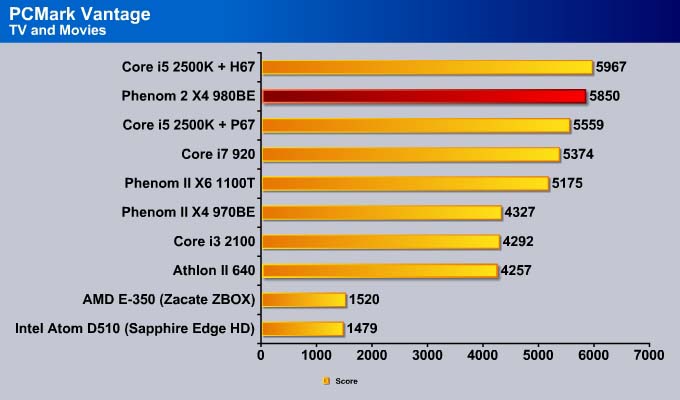
The TV and Movies test consists of transcoding video, where the faster clockspeed of the Phenom II X4 980BE is able to yield better result than the Core i7 920. The PCMark TV and Movie test does not really push all of the cores on the processor and as a result, the 1100T falls behind the 980BE.
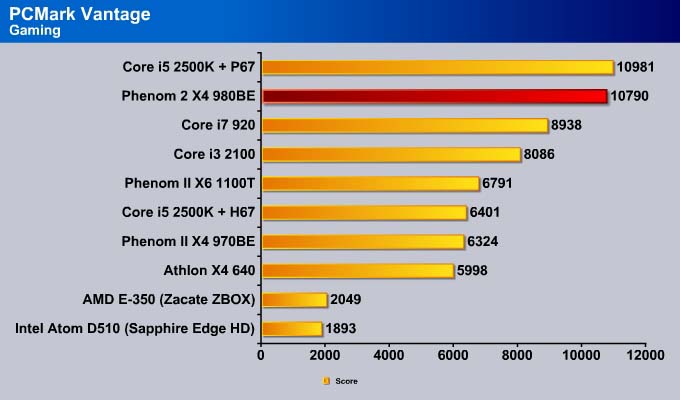
The PCMark Vantage gaming benchmark shows the best case scenario, so readers should take the score with a grain of salt.
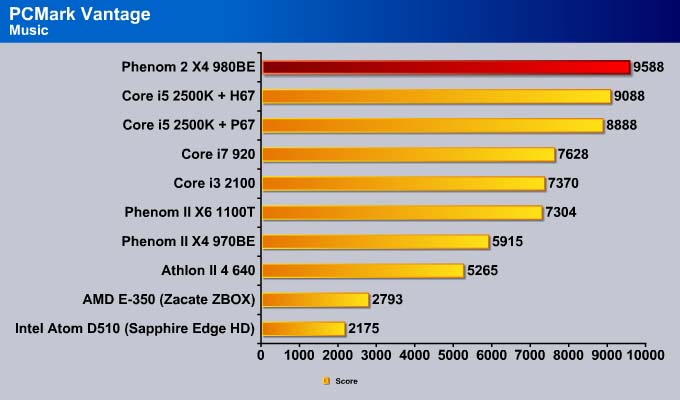
The music test consists of transcoding MP3 to WMA and adding music to Windows Media Player, so it does reflect real-life situations. Transcoding music files is not particularly heavy threaded so the faster clockspeed 980BE easily wins this round.
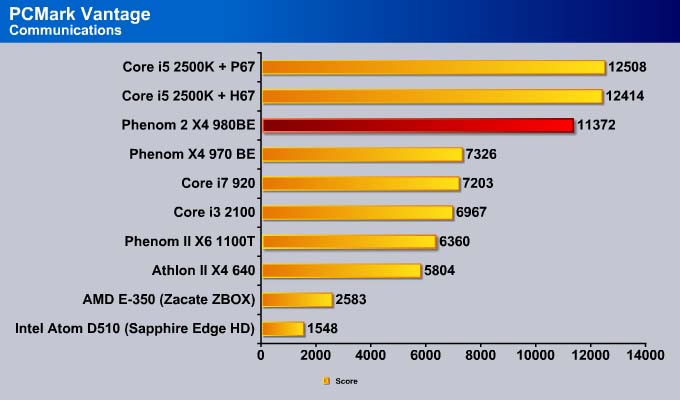
The Communications suite involves light multitasking of data encryption and web page rendering.
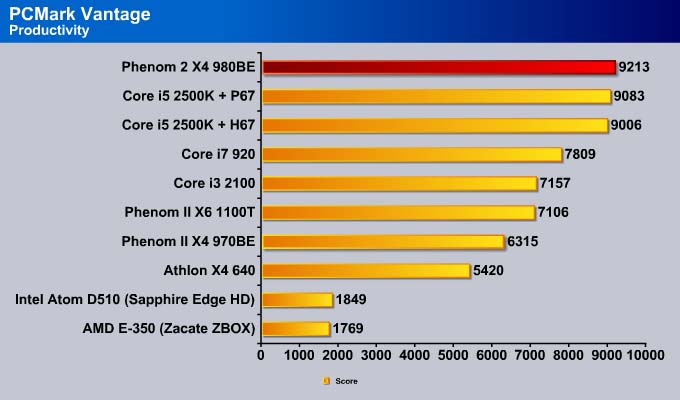
The Productivity test involves four simultaneous tasks that consist of searching contacts in Windows Contacts, searching emails, web page rendering, and application loading. This test simulates common desktop usage with multiple tasks going on at the same time.
The score here can be a true representation of the system performance in a typical environment. Good news for AMD folks as the 980BE beats out the Core i5 2500K by a thin margin.
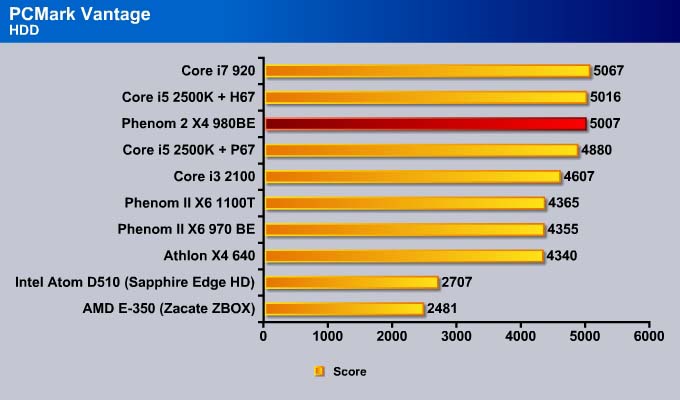
The HDD suite tests specifically the hard drive performance so it does not particularly reflect the CPU performance.
3DMark Vantage

For complete information on 3DMark Vantage Please follow this Link:
www.futuremark.com/benchmarks/3dmarkvantage/features/
The newest video benchmark from the gang at Futuremark. This utility is still a synthetic benchmark, but one that more closely reflects real world gaming performance. While it is not a perfect replacement for actual game benchmarks, it has its uses. We tested our cards at the ‘Performance’ setting.
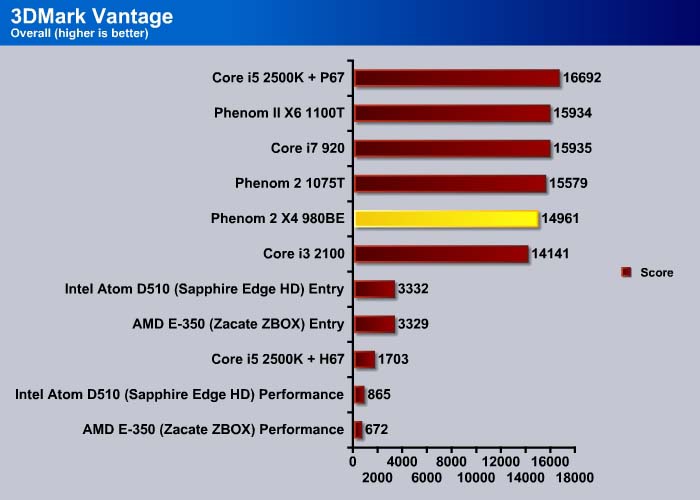
The Phenom II X4 980 BE is a tad slower than the Core i7 920 and the Phenom II X6 1075T. 3DMark Vantage’s overall score combines both the graphics card and the processor speed, so it is expected the six core processors will score slightly higher than the quad cores.

3DMark Vantage’s CPU score shows that the Core i7 920 is about 30% faster than the 980BE due to Hyperthreading support.
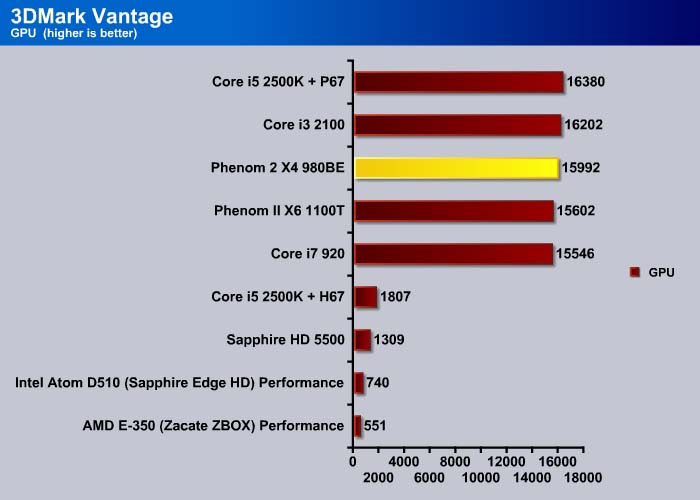
GPU score are about the same for all of the processors. This goes to show that any performance quad core or six-core processor is not going to bug down your graphic card’s performance.
Crysis warhead

Crysis Warhead is the much anticipated standalone expansion to Crysis, featuring an updated CryENGINE™ 2 with better optimization. It was one of the most anticipated titles of 2008.
We ran Warhead using gamer’s setting at resolution of 1280×1024 and DirectX 10. We tested both no AA an 2x AA.
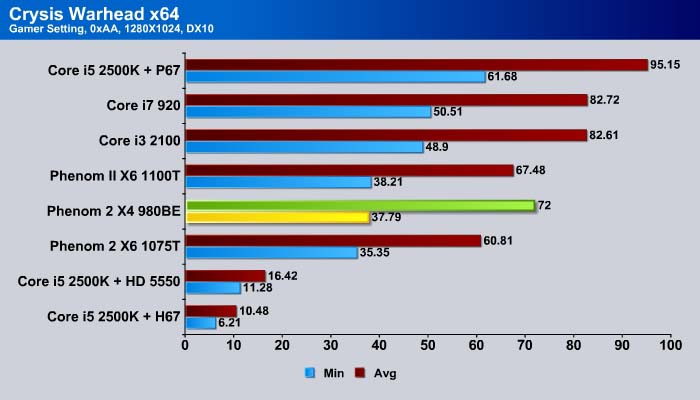
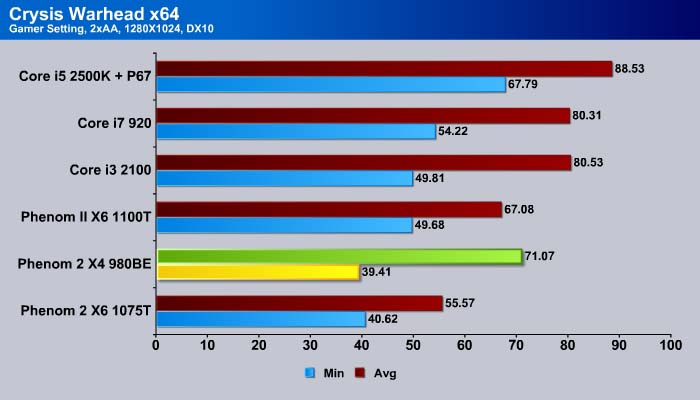
The 980BE performance in game is just what we expected.
Dirt 2

Dirt 2 is the squeal to the popular racing game Colin McRae Dirt. This is a standard racing game, but with an off road twist. Instead of racing Bugattis and Porsches, players race trophy trucks and rally cars.
Again, we put the Core i7 920 OC to 2.8GHz against the X6 1075T and test them with Dirt 2. In this game, we use high setting at 1280×1024 with no AA and 2xAA.
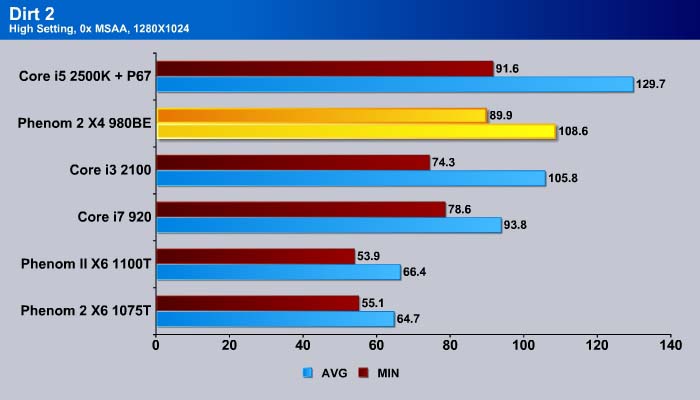
One advantage of the Phenom II X4 processor over the X6 processor is the fact that all four cores will run at 3.7GHz under load, while the 1100T tops off at 3.3GHz. Thus, for lightly threaded applications, the 980BE may come ahead of the 1100T.
POWER CONSUMPTION
We ran Prime95 to stress the CPU in order to measure the overall system power consumption. All of the power saving features (C&Q and SpeedStep) have been enabled, as we envision this is how most people will be running their system.

The power consumption of the 980BE is 9 watts higher but 23 watts lower than the Phenom II X6 1100T. Compare to the Intel processors, we can see it is 23 watts lower idle and 57 watts lower load than the Core i7 920. However, the latest Sandy Bridge Core i5 2500K trumps all of them in terms of power consumption.
OVERCLOCKING
Overclocking the Phenom X4 980 BE past 4GHz is surprisingly easy. We were able to overclock the processor to 4.4GHz simply by raising the multiplier and keeping the voltage at the AUTO setting. We were quite surprised to see that we can reach 4.4GHz on air without any issue by simply raising the multiplier from the default to 22x. This is 700MHz higher than the default clockspeed of 3.7GHz. Quite impressive for a top of the line retail processor as often these processors have slightly lower headroom for overclocking without extra cooling or voltage adjustments
Unfortunately, the law of diminishing returns does apply when it comes to power consumption and overclocking. As soon as we hit the 4GHz mark, the power consumption increases rapidly. When stayed under 3.9GHz, the extra MHz only increased the power consumption by 10 watts but once we hit 4GHz, we saw a 50W jump in the load power consumption. This is something to keep in mind for those who wish to overclock the processor.
Conclusion
The speed bump on today’s launch of the Phenom II X4 980BE does not change anything for AMD. The processor is still not able compete against Intel Sandy Bridge processors like the Core i5 2500K priced at the same bracket. It will not convert any Intel users to AMD systems.
However, the new processor paves a good upgrade option for current AMD users, especially for those who already have AM3 boards that will support the upcoming Bulldozer. Upgrading to the Phenom II X4 980BE from an older dual core will offer extra performance boost, and later once the Bulldozer arrives, users can upgrade to that without incurring a overall system overhaul.
The Phenom II X4 980BE’s performance is fast enough for most tasks, but Intel still wins when it comes to heavy, multi-threaded tasks. Furthermore, Intel Sandy Bridge wins in terms of power efficiency. The good news is that the processor overclocks really well to 4.4GHz on air cooling without any issue, but at cost of higher power consumption.
Overall, the Phenom processor is really looking obsolete, and starts to show its age with Intel’s release of the Lynnfield, Westmere, and the Sandy Bridge architectures. Users who already have a quad-core Phenom should hang on to that till the Bulldozer is released.
| OUR VERDICT: AMD Phenom II X4 980BE | ||||||||||||||||||
|
||||||||||||||||||
| Summary: The speed bump that the Phenom II X4 980BE offers good upgrade options for current AMD owners who need a fast quad-core processor. Unfortunately, it is getting old, since it was launched 2 years ago, and it cannot compete against Sandy Bridge that is priced at a similar price range. |
 Bjorn3D.com Bjorn3d.com – Satisfying Your Daily Tech Cravings Since 1996
Bjorn3D.com Bjorn3d.com – Satisfying Your Daily Tech Cravings Since 1996
